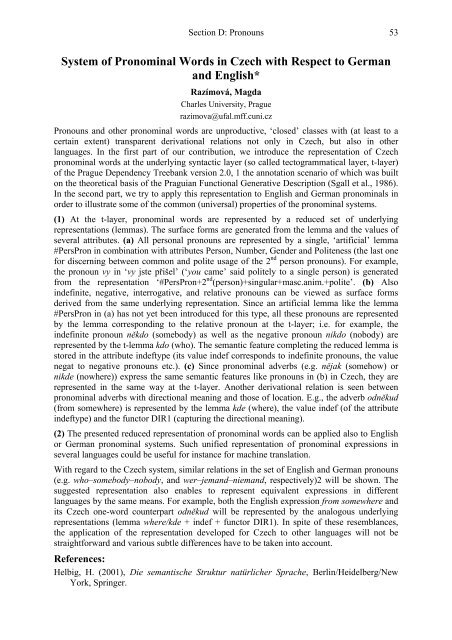Relativism and Universalism in Linguistics - Fachbereich 10 ...
Relativism and Universalism in Linguistics - Fachbereich 10 ...
Relativism and Universalism in Linguistics - Fachbereich 10 ...
You also want an ePaper? Increase the reach of your titles
YUMPU automatically turns print PDFs into web optimized ePapers that Google loves.
Section D: Pronouns 53<br />
System of Pronom<strong>in</strong>al Words <strong>in</strong> Czech with Respect to German<br />
<strong>and</strong> English*<br />
Razímová, Magda<br />
Charles University, Prague<br />
razimova@ufal.mff.cuni.cz<br />
Pronouns <strong>and</strong> other pronom<strong>in</strong>al words are unproductive, ‘closed’ classes with (at least to a<br />
certa<strong>in</strong> extent) transparent derivational relations not only <strong>in</strong> Czech, but also <strong>in</strong> other<br />
languages. In the first part of our contribution, we <strong>in</strong>troduce the representation of Czech<br />
pronom<strong>in</strong>al words at the underly<strong>in</strong>g syntactic layer (so called tectogrammatical layer, t-layer)<br />
of the Prague Dependency Treebank version 2.0, 1 the annotation scenario of which was built<br />
on the theoretical basis of the Praguian Functional Generative Description (Sgall et al., 1986).<br />
In the second part, we try to apply this representation to English <strong>and</strong> German pronom<strong>in</strong>als <strong>in</strong><br />
order to illustrate some of the common (universal) properties of the pronom<strong>in</strong>al systems.<br />
(1) At the t-layer, pronom<strong>in</strong>al words are represented by a reduced set of underly<strong>in</strong>g<br />
representations (lemmas). The surface forms are generated from the lemma <strong>and</strong> the values of<br />
several attributes. (a) All personal pronouns are represented by a s<strong>in</strong>gle, ‘artificial’ lemma<br />
#PersPron <strong>in</strong> comb<strong>in</strong>ation with attributes Person, Number, Gender <strong>and</strong> Politeness (the last one<br />
for discern<strong>in</strong>g between common <strong>and</strong> polite usage of the 2 nd person pronouns). For example,<br />
the pronoun vy <strong>in</strong> ‘vy jste přišel’ (‘you came’ said politely to a s<strong>in</strong>gle person) is generated<br />
from the representation ‘#PersPron+2 nd (person)+s<strong>in</strong>gular+masc.anim.+polite’. (b) Also<br />
<strong>in</strong>def<strong>in</strong>ite, negative, <strong>in</strong>terrogative, <strong>and</strong> relative pronouns can be viewed as surface forms<br />
derived from the same underly<strong>in</strong>g representation. S<strong>in</strong>ce an artificial lemma like the lemma<br />
#PersPron <strong>in</strong> (a) has not yet been <strong>in</strong>troduced for this type, all these pronouns are represented<br />
by the lemma correspond<strong>in</strong>g to the relative pronoun at the t-layer; i.e. for example, the<br />
<strong>in</strong>def<strong>in</strong>ite pronoun někdo (somebody) as well as the negative pronoun nikdo (nobody) are<br />
represented by the t-lemma kdo (who). The semantic feature complet<strong>in</strong>g the reduced lemma is<br />
stored <strong>in</strong> the attribute <strong>in</strong>deftype (its value <strong>in</strong>def corresponds to <strong>in</strong>def<strong>in</strong>ite pronouns, the value<br />
negat to negative pronouns etc.). (c) S<strong>in</strong>ce pronom<strong>in</strong>al adverbs (e.g. nějak (somehow) or<br />
nikde (nowhere)) express the same semantic features like pronouns <strong>in</strong> (b) <strong>in</strong> Czech, they are<br />
represented <strong>in</strong> the same way at the t-layer. Another derivational relation is seen between<br />
pronom<strong>in</strong>al adverbs with directional mean<strong>in</strong>g <strong>and</strong> those of location. E.g., the adverb odněkud<br />
(from somewhere) is represented by the lemma kde (where), the value <strong>in</strong>def (of the attribute<br />
<strong>in</strong>deftype) <strong>and</strong> the functor DIR1 (captur<strong>in</strong>g the directional mean<strong>in</strong>g).<br />
(2) The presented reduced representation of pronom<strong>in</strong>al words can be applied also to English<br />
or German pronom<strong>in</strong>al systems. Such unified representation of pronom<strong>in</strong>al expressions <strong>in</strong><br />
several languages could be useful for <strong>in</strong>stance for mach<strong>in</strong>e translation.<br />
With regard to the Czech system, similar relations <strong>in</strong> the set of English <strong>and</strong> German pronouns<br />
(e.g. who–somebody–nobody, <strong>and</strong> wer–jem<strong>and</strong>–niem<strong>and</strong>, respectively)2 will be shown. The<br />
suggested representation also enables to represent equivalent expressions <strong>in</strong> different<br />
languages by the same means. For example, both the English expression from somewhere <strong>and</strong><br />
its Czech one-word counterpart odněkud will be represented by the analogous underly<strong>in</strong>g<br />
representations (lemma where/kde + <strong>in</strong>def + functor DIR1). In spite of these resemblances,<br />
the application of the representation developed for Czech to other languages will not be<br />
straightforward <strong>and</strong> various subtle differences have to be taken <strong>in</strong>to account.<br />
References:<br />
Helbig, H. (2001), Die semantische Struktur natürlicher Sprache, Berl<strong>in</strong>/Heidelberg/New<br />
York, Spr<strong>in</strong>ger.

















